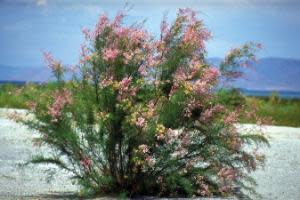Bad, Naughty Invasive Plants

Salt cedar (Tamarisk ramosissima)
First of all, we must remember there really are no bad plants – just plants growing in the wrong places. Okay, with that out of the way…
The City of Portland is on a mission to try to control the spread of 15 of the most perniciously invasive plant species in the Metro area.
These plants have been introduced as garden ornamentals, in feed or, in some cases, have simply hitch-hiked on people’s shoes, in bird poop or hidden among other desirable plants. They usually start out innocently enough – sometimes, if they’re pretty, they are even tended by gardeners – but soon become established and begin to spread out of control.
In response to the overwhelming number of invasive plants plaguing our region, the City has adopted the Portland Early Detection and Rapid Response program to try to prevent the spread of the most fiercely invasive plants on the lists. Beginning July 1, 2010, Portland property owners are required to remove any species on the Required Eradication List.
Already wreaking havoc on agricultural land and native plants in our region, these invaders have been aggressively removed from public lands in recent years. Now, the City is requiring property owners to share the responsibility – since removing the plants from public property does no good if they just keep creeping back in from untended private property.
The City offers property owners free assistance to identify and remove the following plants:
1. Russian Knapweed (Acroptilon repens )
2. False Brome (Brachypodium sylvaticum )
3. Italian Thistle or Slender Flowered Thistle (Carduus pycnocephalus and Carduus tenuiflorus
4. Jubata grass (Cortaderia jubata )
5. Paterson’s Curse (Echium plantagineum )
6. Giant Hogweed (Heracleum mantegazzianum )
7. Orange Hawkweed (Hieracium aurantiacum )
8. Meadow Hawkweed (formerly listed as Yellow Hawkweed)(Hieracium pratense, syn. H. cespitosum )
9. Policeman’s Helmet (Impatiens glandulifera )
10. Scotch Thistle (Onopordum acanthium )
11. Common Reed (Phragmites australis – introduced variation only)
12. Kudzu (Pueraria lobata )
13. Blessed Milk Thistle (Silybum marianum )
14. Saltcedar (Tamarix ramosissima )
15. Gorse (Ulex europaeus )
You can identify these plants here – click on the name for images and details. The page also includes fact sheets to help with eradication and contact information if you need to speak with someone.
While many of these plants show up in disturbed areas alongside roads or on large construction sites and the like, I have seen several of them popping up in people’s gardens. I even found Scotch thistle emerging in my own garden this spring – probably spread by birds. It’s worth taking a look at the list and just getting to know these plants so you can keep an eye out for them. Several of them have very icky qualities, such as producing toxic sap (giant hogweed) or painfully glass-like, sharp leaves (Scotch thistle) that make removal quite torturous. But, it must be added, not impossible!
{% display:image for:post image:1 align:right width:350 %}
More information on invasive plant management can be found here.
